Employee Development Plan Examples

Imagine you get a message: “I’ve given my notice today. While I respect the company, I want to grow in ways that match my skills and interests, but that conversation never seemed to go anywhere here.”
You probably don’t want to hear this from your top performers. And yet, it’s becoming increasingly common as employees seek more personalized development opportunities.
Cookie-cutter training no longer meets employee development needs. According to the research, 80% of employees expect personalized learning in 2024 – and with emerging tech making this scalable, more organizations are shifting toward individualized training approaches.
In this article, we’ll cover reasons why you should invest in personalized employee development programs, share employee development plan examples for various use cases, and provide 7 tips to make your EDPs impactful.
What Is an Employee Development Plan?
An Employee Development Plan (EDP) is a structured framework that guides professional growth. It’s a document created through manager-employee conversations and reviewed quarterly to track progress.
The employee development plan aligns individual career aspirations with organizational goals while mapping out specific steps for development and improvement.
The framework is also known as career pathing, career mapping, or an individual or career development plan.
Why Are Employee Development Plans Important for Employee Development?
Investment in employee development plans may seem like another administrative task in an already busy schedule. However, when implemented thoughtfully, these plans deliver value that far outweighs the time investment. Let’s explore why effective professional development plans are worth your time and resources.
For companies
- They improve training and development program results. LinkedIn reports that the third top reason to spend more time learning in 2024 is having a training program that’s personalized to an employee’s career goals and interests.
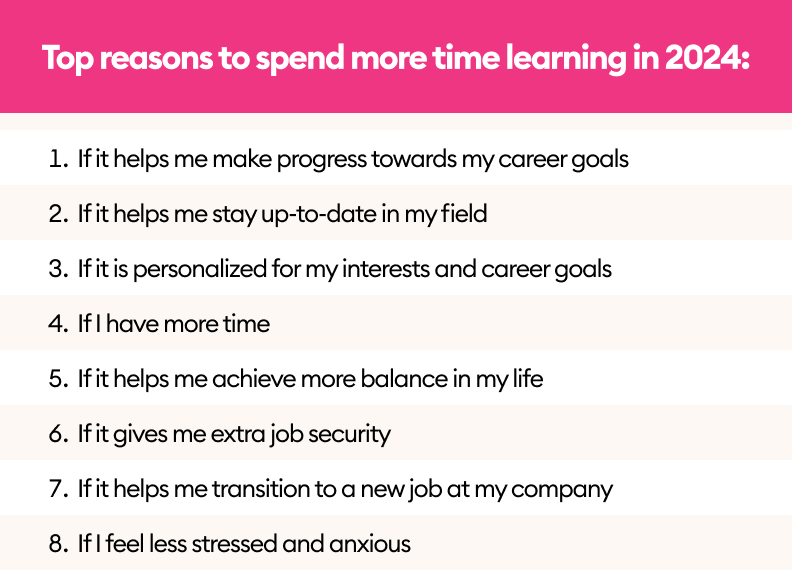
2. EDPs attract top talent. Top performers seek organizations that invest in their growth ー they want to know there’s a clear path to advancement before they even apply. And, as we mentioned in the introduction, 80% of employees expect personalized learning in 2024.
3. They’ll increase retention rates. Career development was the most frequently cited reason for leaving a company in 2023 and has been the most cited reason for leaving by employees every year since Work Institute began tracking in 2010.
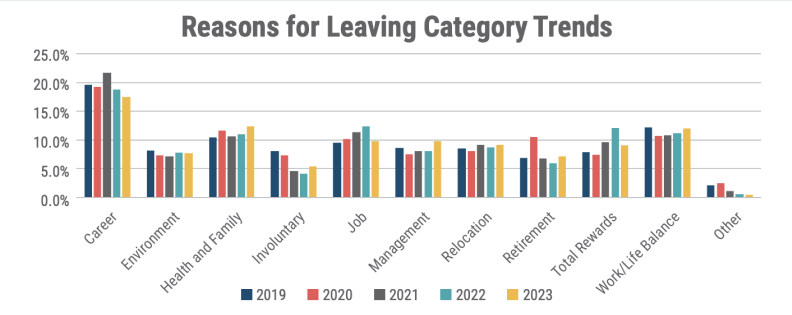
Based on Pew Center Research data, more than 60% of U.S. employees who quit their jobs in 2021 cited a lack of career advancement opportunities as a leading reason for leaving.
And according to the same Work Institute Retention Report, career development is also the factor that companies have the most control over when compared to other retention drivers. This makes professional development your most powerful tool for improving retention rates.
When employees have a clear understanding of their growth path ahead, they’re more likely to engage long-term with the organization. This increased retention creates a virtuous cycle. By advancing more of your current employees’ careers, you not only keep valuable talent but dramatically decrease the need for external recruiting and its associated costs.
- They improve employees’ mental health. Based on the 2023-2024 SHRM State of Workplace Report, employees’ mental health was the second top concern for organizations in 2023. This focus on mental health is particularly relevant to development planning, as research shows that a lack of growth opportunities is one of the top drivers of negative outcomes, along with job security and work/life balance.
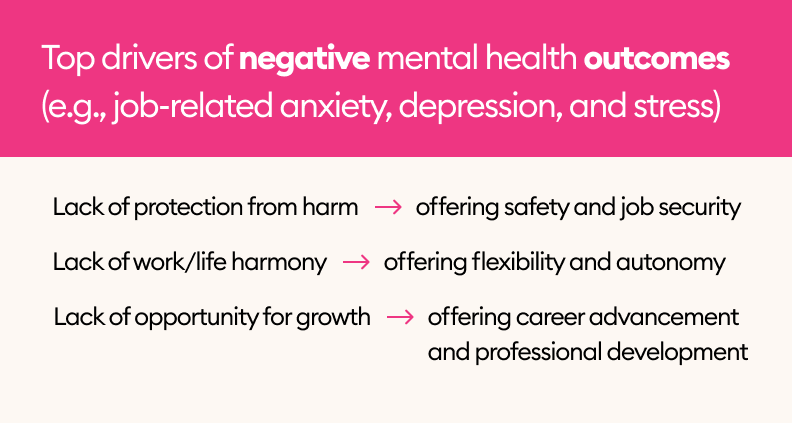
5. Moreover, this is what we’ve found in this Reddit post about a personal development plan: “I find that it [the plan] helps with my “imposter syndrome” anxieties quite a bit. I constantly catch myself thinking I’m about to be fired till I have these [career] discussions.”
- EDPs leverage internal hiring to its full potential. Well-designed professional development plans create a strong internal talent pipeline, making it easier to promote from within. When employees see clear paths for advancement and receive targeted development support, internal mobility becomes a natural outcome. This approach also leads to more successful role transitions (since these employees already understand company culture and processes).
For employees
1. They keep their professional growth on track. An employee development plan transforms vague career aspirations into concrete action steps. It gives employees a sense of ownership over their professional journey. Instead of waiting for opportunities to appear randomly, employees can proactively work toward specific goals that an EDP helped define. Without an employee development plan, career paths might feel unclear or dependent solely on management decisions.
2. EDPs improve job satisfaction. Employee job satisfaction increases when they clearly understand their career growth path and receive strong company support. As career development expert Mark Herschberg says, “Goals that reflect an employee’s interests, strengths, preferred location, and desired schedule are key to their overall job satisfaction and should be part of their employee development plan.”
3. They’ll make sense of what to learn within a company’s training program. Professional development plans help employees navigate through available learning resources with clear purpose and direction. Rather than randomly selecting training modules, employees can focus on learning opportunities that directly support their career goals and the company’s strategic objectives.
With analytics and AI-powered insights increasingly available, employees can better track their progress and adjust their learning paths to stay aligned with both personal development goals and organizational needs.
9 Employee Development Plan Examples to Inspire Your Organization’s Template
Based on our analysis of dozens of employee development action plan examples and industry best practices, we’ve classified examples into four main categories: skill-based, succession-focused, management development, and new career development plans. This classification reflects the most common development scenarios that organizations face.
To choose the right type for your needs:
- Use skill-based plans to improve performance in current roles.
- Consider succession plans for developing future leaders and critical role backups.
- Apply management development plans for growing people managers.
- Choose career transition plans when supporting internal mobility.
Skill-based employee development plans
These plans focus on helping employees acquire new skills and close skill gaps in order to develop in their current roles. They’re particularly effective when an employee needs to:
- Master new skills necessitated by technological changes or evolving job requirements.
- Address specific skill gaps identified through performance reviews or self-assessment.
- Develop job-related technical skills and soft skills.
A skill-based plan typically includes:
- Aligning employee and business goals.
- Identifying skills to achieve the aligned goals.
- Prioritizing the skills.
- Specific learning activities and timelines.
- Regular progress reviews to ensure continuous learning.
For example, a marketing specialist might need to develop new skills in social media analytics. Their plan would map out specific training modules, mentoring sessions, and practical exercises to build competency in this area.
This approach supports continuous learning by breaking development down into manageable chunks while maintaining clear connections to job performance and career growth.
Let’s look at some simple employee development plan examples in PDF format that demonstrate this approach:
Employee development plan – example 1
Yale University Individual Development Planning
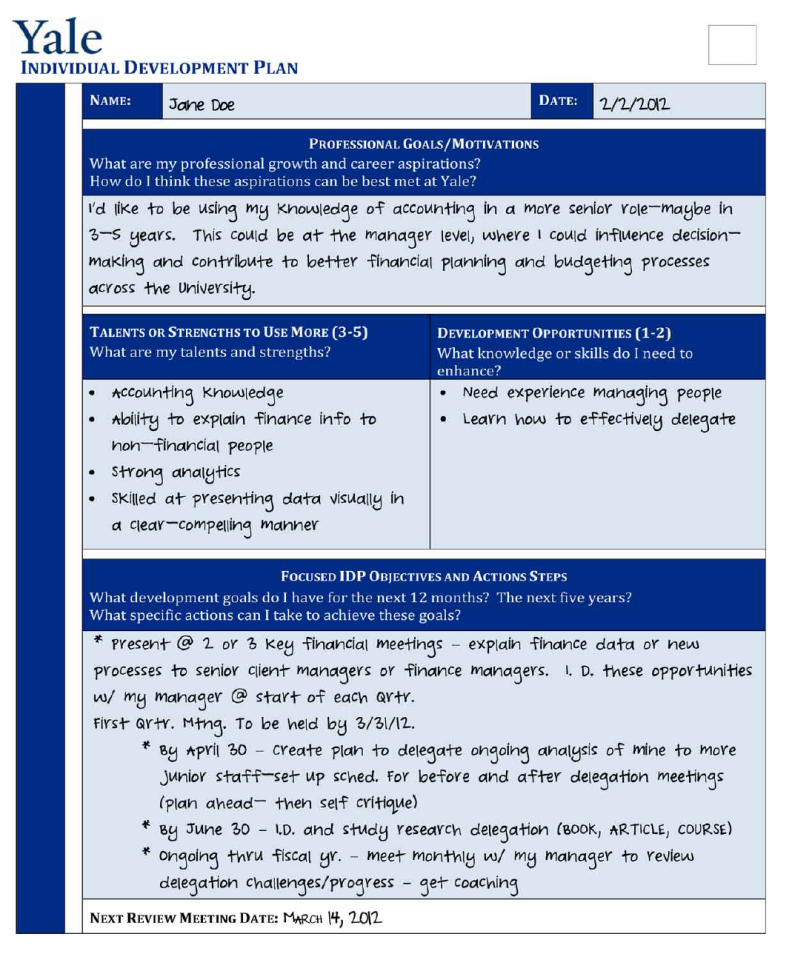
Employee development plan – example 2
Rochester Institute of Technology Employee Development Plan
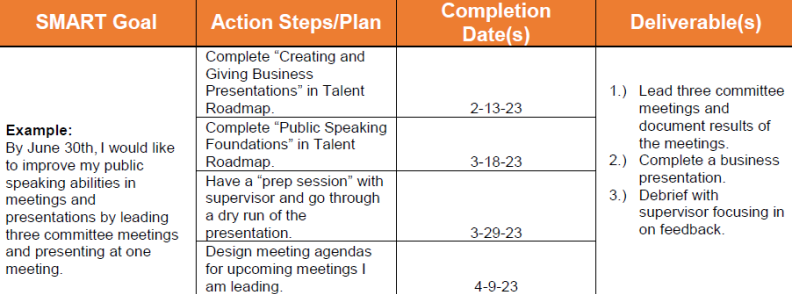
Succession development plans
Effective succession planning prepares high-potential employees for critical roles within the organization.
A succession development plan typically includes:
- Identifying critical positions and potential successors.
- Setting transition timing requirements.
- Assessing current employees’ competencies and gaps.
- Setting short-term and long-term goals to prepare for a new position.
- Planning resources needed to achieve each goal.
- Clear criteria for measuring the employee’s progress and succession readiness.
For example, a senior analyst being groomed for a department head role would have a plan outlining leadership training, cross-functional projects, mentoring relationships, and gradual exposure to higher-level responsibilities.
This approach to succession planning helps in two key ways:
- It keeps the organization stable by making sure there are trained people ready to step into important roles.
- It shows talented employees exactly how they can move up in the company.
Let’s look at the following employee individual development plan examples for leadership that demonstrate this plan type:
Employee development plan – example 3
Lindenwood University Planning for Employee Development
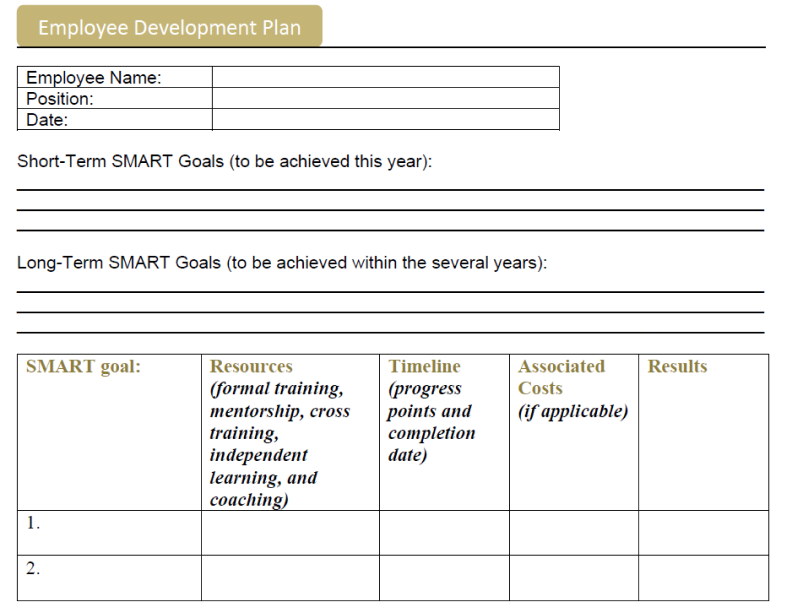
Employee development plan – example 4
U.S. NRC – The Individual Plan Process
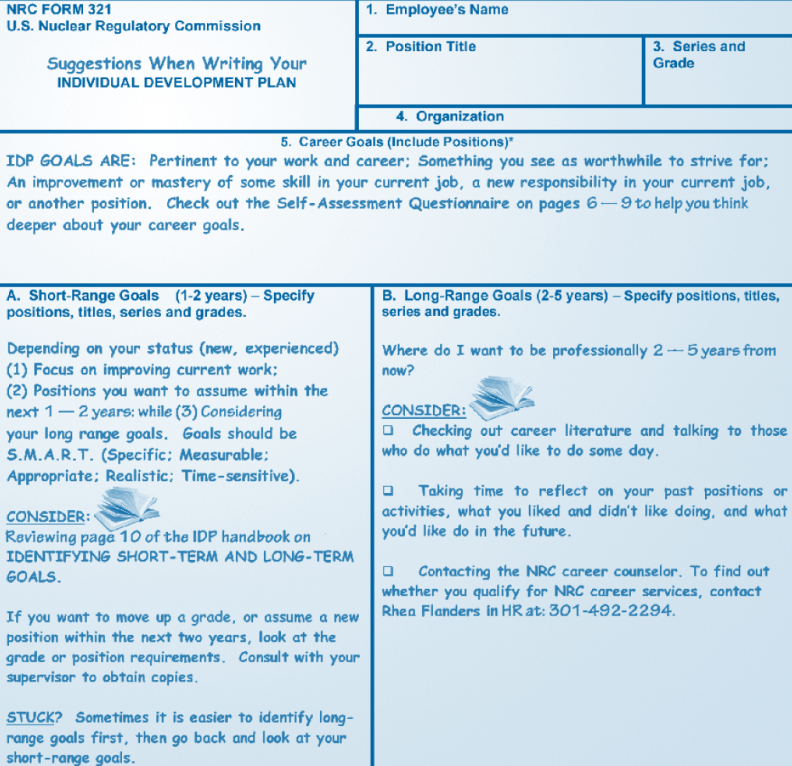
Development plans for managers
These plans focus on enhancing the skills of current managers to perform their roles and lead their teams successfully. A leadership development plan is particularly effective when an employee needs to:
- Enhance their leadership skills in their current management role.
- Prepare for more senior leadership roles in the organization.
A management development plan typically includes:
- Assessment of current leadership skills and competency gaps.
- Developmental activities and resources.
- Practical experience opportunities.
- Progress evaluation methods.
For example, a regional sales manager struggling with team burnout and high turnover would have a leadership development plan focusing on emotional intelligence and modern management practices.
Here’s one of the employee personal development plan examples specifically designed for management roles:
Employee development plan – example 5
University of South Carolina Individual Development Plan
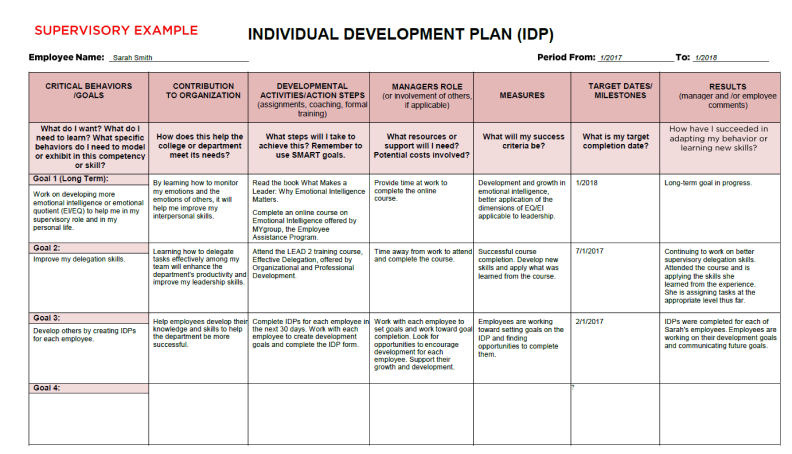
New career development plan
This plan guides employees who want to move into different roles within your organization.
A career transition plan typically includes:
- Assessment of the employee’s current skills against target role requirements.
- Identification of key development opportunities and gap areas.
- A timeline for acquiring new qualifications.
- Structured cross-training and job shadowing schedules.
- Regular check-ins to evaluate development efforts and adjust as needed.
For example, let’s say a customer service rep wants to join the marketing team. Their plan would include:
- Getting key marketing certifications.
- Finding a mentor from the marketing team.
- Taking on small marketing tasks while still doing their current job.
This approach helps the employee transition to new roles smoothly while staying with the company. It encourages internal mobility and reduces hiring costs.
The following examples of employee development plans showcase different approaches to career transition planning:
Employee development plan – example 6
McGill University Individual Development Plan
This template was included among the employee individual development plan examples shared by Code2day’s (recruitment agency) founder, Alex Novokreshchenov.
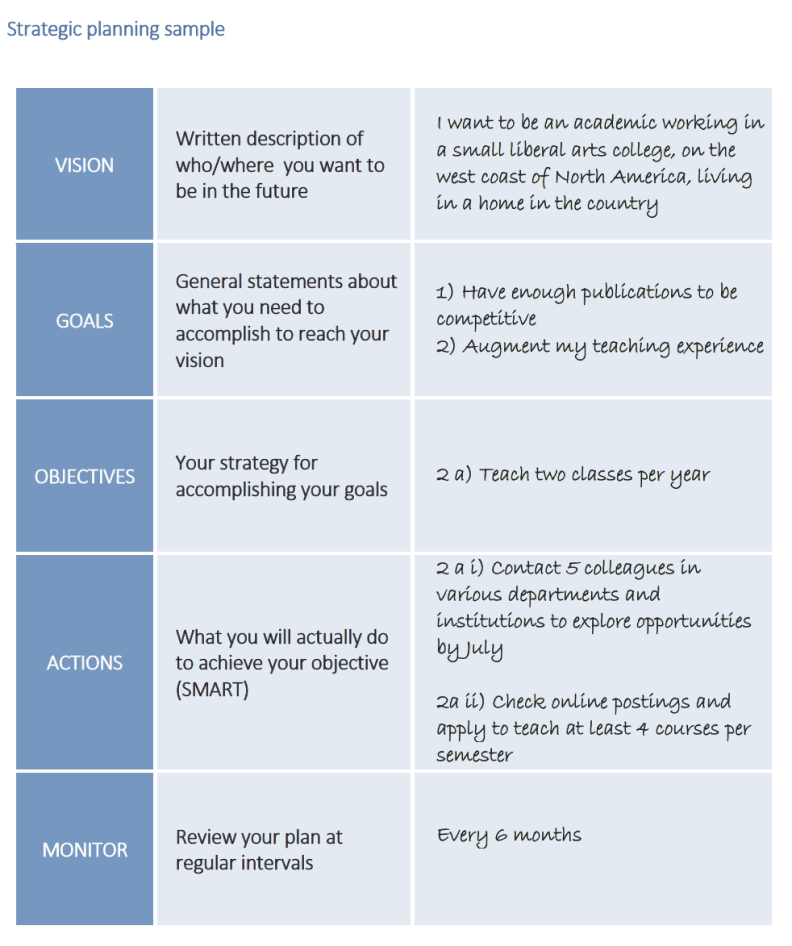
Employee development plan – example 7
SHRM Employee Career Development Plan Form
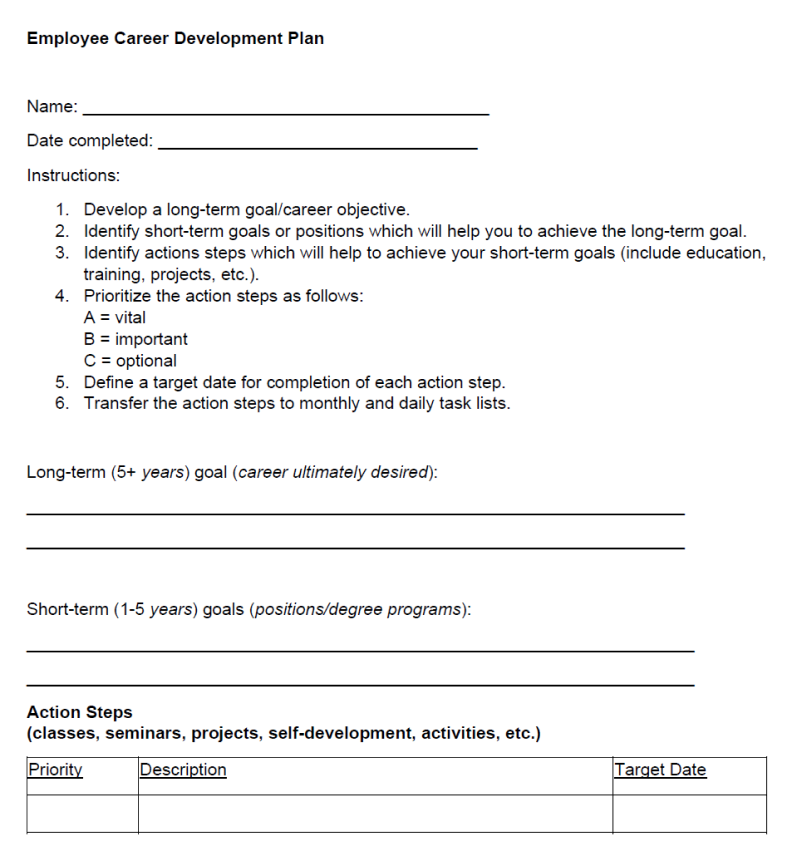
Performance-based employee development plans
These plans focus on helping employees improve their current job performance through targeted skill enhancement and behavioral changes. They’re particularly effective when an employee needs to:
- Address specific performance gaps identified in reviews.
- Meet new performance standards or expectations.
A performance-based plan typically includes:
- Clear performance metrics and standards.
- Specific areas needing improvement.
- Detailed action steps with timelines.
- Required resources and support.
- Success metrics to measure improvement.
For example, a sales representative who is not meeting their quarterly targets would have a plan outlining specific sales techniques to master, role-playing exercises, mentoring sessions with top performers, and weekly progress reviews.
This approach helps transform underperforming employees into valuable contributors while providing clear accountability and support structures for improvement.
Employee performance development plan – example 8
Zendesk employee development templates.
These professional employee development plan examples in PDF format from Zendesk demonstrate how to structure performance improvement plans:
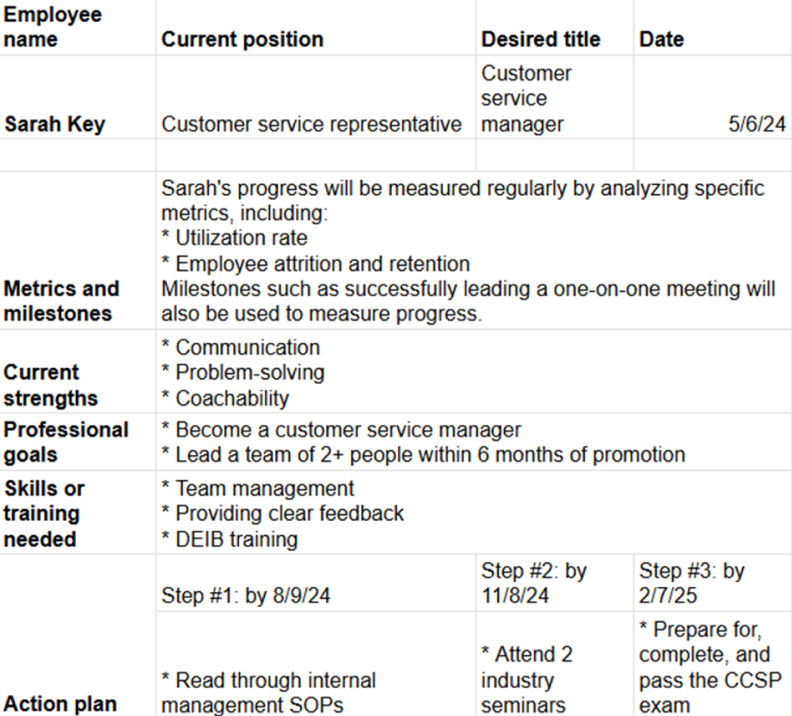
Employee performance development plan – example 9
LinkedIn professional development plan template
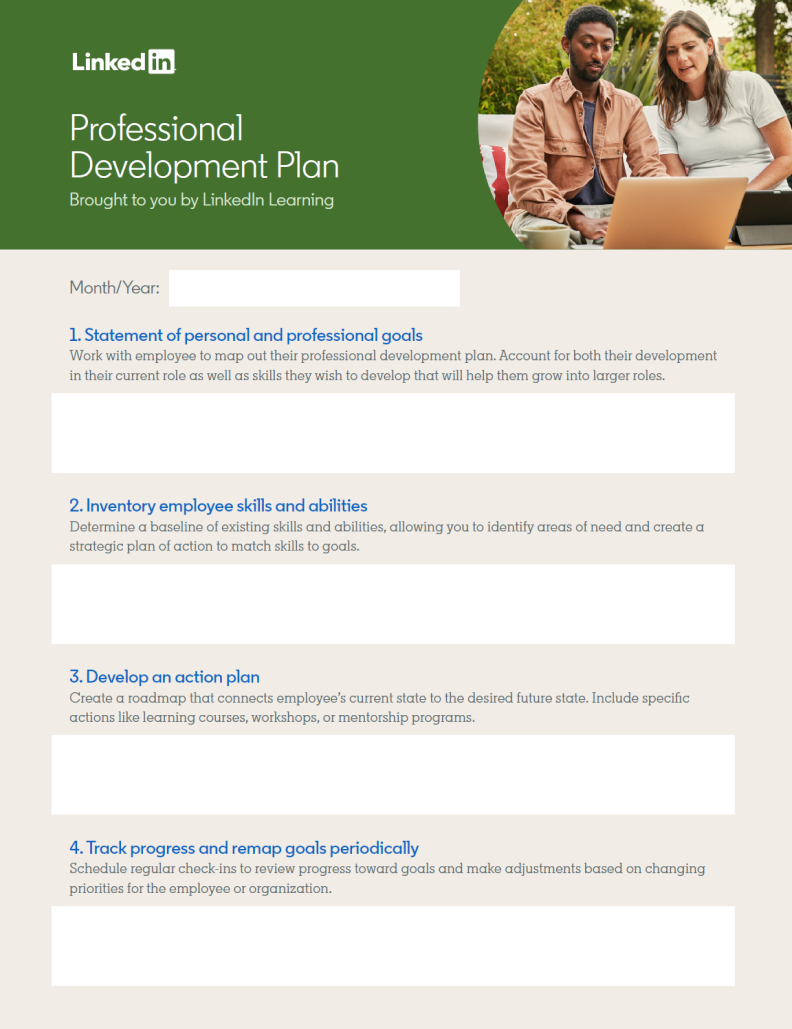
7 Tips on Creating an Effective Employee Development Plan
All too often, employee development plans end up being just annoying paperwork for employees rather than delivering meaningful impact on their career development and business goals.
This section will help you avoid that fate. These practical tips will ensure your employee development plans drive growth and business impact, not just bureaucracy.
Tip 1. Clarify business goals
Start by ensuring clear visibility in your company’s long-term vision and immediate priorities. They will help you align employee interests with business needs when creating EDPs.
For example, if your company’s long-term goal is to become a leader in sustainability, key employee development areas could be understanding environmental regulations and policies and mastering green product design and manufacturing.
Tip 2. Develop managers’ coaching capabilities
Equip your managers with the coaching skills to have meaningful career conversations and provide ongoing feedback.
Direct managers play a pivotal role in personalizing employee career development plans. Their involvement in understanding each employee’s purpose, goals, and personal career objectives lays the foundation. While employees are ultimately responsible for their careers, leadership support is essential in guiding them along the path.
This Brandon Hall Group study found that only 23% of leaders currently receive adequate training to assist employees with career development initiatives. It might be your competitive advantage.
Tip 3. Customize employee career development plans
To make sure employee development really works, customization matters — different roles require specific resources, training paths, and learning opportunities.
The best way to customize these paths for your development programs is to use an LMS like iSpring LMS. The platform has a dedicated Development Plans module where you can:
- Create role-specific training checklists for new and experienced employees. Add action-based tasks for specific roles, build clear skill development plans, and easily assign them to relevant employee groups.
- Assign mentors and supervisors. They’ll provide hands-on guidance, help employees overcome training challenges, and apply what they’ve learned.
- Track progress with detailed reports. Supervisors and training managers can see how each employee is doing and where additional training or skill development resources might be necessary.

Tip 4. Establish a systematic needs assessment process
Have an effective process to discover and collect employee needs and interests — one that consistently produces actionable insights while making employees feel that they are being heard.
Here is the process followed by the University of Arizona’s (UA’s) HR division. They have a resource page with instructions so everyone understands how to go through the process. UA has 5 main steps to discover employee development and growth needs:
- Self-reflection. Employees complete a self-reflection form that details accomplishments, strengths, goals, alignment with the university’s mission, and plans for achieving their goals.
- Supervisor preparation. Supervisors review the self-reflection form and prepare notes to guide the conversation.
- Scheduled conversations. Then, supervisors conduct in-person or video-based discussions. This ensures clarity in expectations and engagement.
- Constructive feedback. Supervisors provide feedback during the conversation. They identify learning opportunities and support goal achievement.
- Documentation and follow-up. The discussion is documented and shared with the employee.
Tip 5. Navigate misalignment with transparency
When employee goals and company needs don’t align, address the issue with transparency, set clear expectations about what is achievable, and collaborate on a professional development plan to prepare both the employee and the organization for future opportunities. For example, if an employee seeks a leadership role that isn’t available, you might encourage them to lead a cross-functional project to develop their leadership skills.
Tip 6. Review progress systematically
Monitor the employee’s progress and adapt plans as needed. As employees actively work toward their goals with their individualized career paths, schedule regular check-ins to track their progress. Ensure the plan remains flexible, adjusting timelines or targets as necessary.
To simplify the tracking process across hundreds of employees, we recommend using an LMS that allows you to collect 360-degree employee feedback to stay on top of staff progress.
The 360-degree assessment feature lets you see how employees’ skills improve over time. You can compare their abilities before and after training and development programs to measure if the employee development plan is working.
Here’s how the results look in an LMS like iSpring LMS:
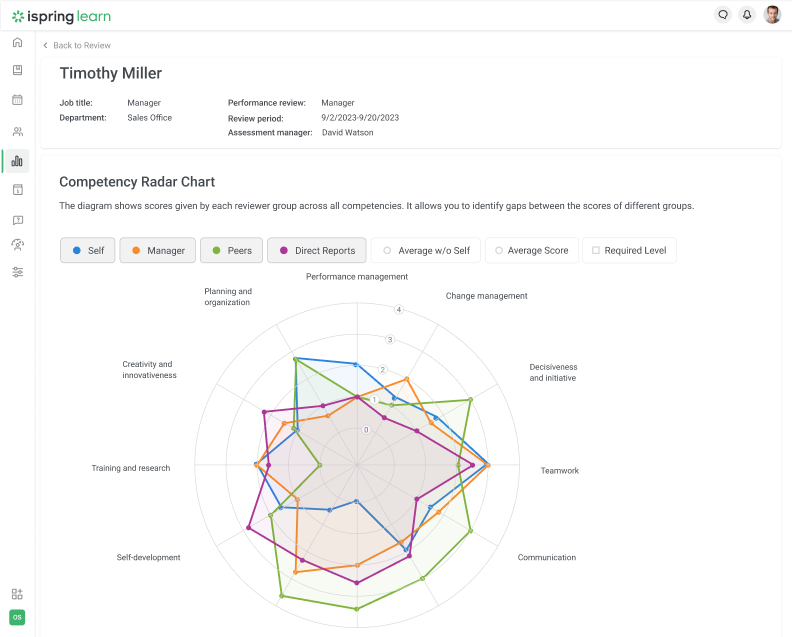
If you’re thinking about how to simplify the creation of personalized learning tracks for hundreds of employees, book a free live demo with iSpring training experts.

Tip 7. Celebrate alignment
Recognize and reward employees who achieve their goals while contributing to strategic business objectives. This reinforces alignment and motivates others to follow suit. For example, offer spot bonuses or skill-based pay increases.
FAQ on Employee Development Plans
Still have questions? Here are expert answers to the most common queries about an employee development plan.
What is the difference between an IDP (individual development plan) and an EDP (employee development plan)?
Most organizations use these terms to describe the same thing: a plan for professional development.
What should I write in my employee development plan?
Individual employee development plans in PDF format typically have the following structure:
- Basic information. Employee/manager details and review timeline
- The employee’s career aspirations. Short- and long-term career goals.
- Skills assessment. Current competencies and gaps analysis.
- Development goals. SMART goals with clear metrics.
- Action steps. Specific learning activities and timelines.
- Progress tracking. Milestones and check-in schedule.
What are the best ways to encourage employee growth and career development?
Employees aren’t interested in working on their EDPs?
- Uncover the “why” – have honest conversations to understand their hesitation.
- Is it a lack of time?
- Unclear career path?
- Previous negative experiences?
- Make it relevant to them.
- Connect employee development to their personal goals.
- Show immediate benefits to their current role.
- Highlight success stories from peers.
- Remove barriers.
- Allocate protected time for development.
- Simplify the employee development planning process.
- Provide easy access to learning resources.
- Establish accountability and support.
- Set small, achievable milestones.
- Schedule regular check-ins.
- Pair them with motivated peers.
- Celebrate small wins.
What are some examples of employee development plan goals?
- Master a specific software or tool (e.g., Salesforce, Python, or Adobe Photoshop) to enhance job performance and efficiency.
- Boost monthly sales by 20% within the next six months through advanced negotiation and upselling training.
- Lead a cross-functional team project within the next quarter to gain experience in managing teams and decision-making.
- Reduce project completion times by 15% by adopting productivity techniques like task prioritization or time blocking.
- Obtain a Google Analytics certification within three months to improve digital marketing insights and strategies.
Conclusion
As we’ve seen, with 80% of employees expecting personalized learning and career development remaining the top reason for turnover since 2010, implementing an effective employee development plan is crucial for impactful training and development programs.
Finding and customizing the right employee individual development plan examples for your organization is only the tip of the iceberg. To make EDPs more than just paperwork, they should be a cornerstone of your L&D strategy. This involves:
- Using insights from EDPs to inform your overall L&D priorities and programs.
- Ensuring that your L&D offerings directly support the development goals identified in EDPs.
- Creating clear processes for:
- Plan creation and goal-setting.
- Implementation support and resource allocation.
- Regular progress reviews and updates.
- Measuring impact on both individual employee growth and business outcomes.
We hope this article has provided you with some clarity about creating effective employee development plans for your organization.





